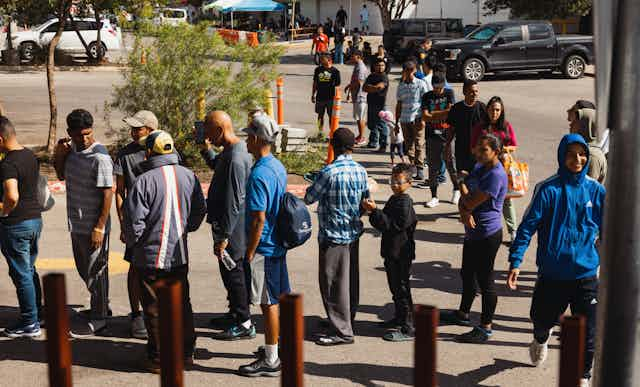Like many other Republican candidates and conservative talk show hosts, Kari Lake is using the racially tinged issue of immigration to fuel turnout in her gubernatorial campaign in Arizona. The former television anchor has boldly proclaimed that on her first day as governor, she would declare the state under “invasion.”
Lake is not the only conservative politician to speak in hyperbolic terms about immigration during the midterm campaign season. Texas Governor Greg Abbott, outgoing Arizona Gov. Doug Ducey and Florida Gov. Ron DeSantis have sent migrants on buses or planes to mostly cities in the Northeast, most notably New York and Washington D.C., to draw attention to what they perceive as a crisis – and to appeal to their political base.
In a letter to U.S. Department of Homeland Security Secretary Alejandro Mayorkas, U.S. Senators Ted Cruz of Texas and Lindsey Graham of South Carolina described his efforts to combat the crisis as a “dereliction of duty” and possible grounds for his impeachment.
“These astronomically high numbers are due in no small part to the political decision to rescind a number of President Trump’s policies that were stemming the flow of illegal aliens and illicit drugs across the southern border,” Cruz and Graham’s letter said.
Indeed, the numbers that were used to support their claims were tweeted in September 2022 by Cruz, who said that 4.2 million “illegal aliens” had crossed the border since the inauguration of President Joe Biden in 2021.
The Republican National Committee says that number, which it claims represents “a crisis of Democrats’ making,” breaks down to about 2 million so far each year.
As midterms approached, citing these numbers had become commonplace – and misleading. As an immigration researcher and expert on international borders, I have followed the figures that purport to track the number of immigrants crossing the border for years. I am worried that the figures cited are being repeated without providing an adequate explanation.
These numbers represent encounters, not the number of individuals who have come across the border. It’s a misleading and inaccurate way of describing the number of people coming into the U.S.
The meaning of encounters
For decades, U.S. Customs and Border Protection has released the number of arrests at the United States-Mexico border. But that changed two years ago as a result of the COVID-19 pandemic and new agreements signed with the Mexican government.
In March 2020, the federal agency announced that it would add another category to the total number of apprehensions – the number of expulsions.
The combined statistics were then called “encounters.”
According to the U.S. Customs and Border Protection, there were a total of around 4,450,240 encounters from January 2021 to October 2022.

But an “encounter” does not mean a single person or a first attempt to enter.
The Department of Homeland Security defines an encounter as a noncitizen who is declared to be inadmissible for not having a U.S. passport, green card or visa. But “encounters” also includes the people who are allowed to stay in the U.S. as they apply for asylum or a humanitarian visa for reasons such as political persecution or fleeing human trafficking.
Migrants and asylum seekers often try to enter multiple times and are counted separately each time.
For example, in August 2022, U.S. Customs and Border Patrol revealed that over 22% of encounters are people who had at least one prior encounter in the previous 12 months.
The report further reveals that only 36% percent of the encounters with people from Mexico and northern Central America are unique encounters – and only 35% percent for those from Venezuela, Cuba and Nicaragua.
It is hard to know, with the current counting system, just how many unique individuals interacted with agents at the border. What is certain is that because of multiple counts of the same individuals, the total number is less than the 4.2 million new undocumented immigrants that Cruz claims have entered the U.S. since the start of the Biden administration.
Impact of COVID-19 on migration
In addition to counting the same people multiple times, the number of total encounters overestimates the number of individuals because of another reason: the huge number of expulsions that are used in counting the total number of encounters.
Enacted in 2020 to reduce the spread of COVID-19, “Title 42” – a provision of U.S. public health law – allows U.S. law enforcement officers to immediately deny entry to asylum seekers.

Under Title 42, around 51% of the people encountered are immediately expelled or put into deportation proceedings. After being sent back, some may try again to have their asylum cases heard, and are counted one more time as “encountered.”
According to the Biden administration, 1.3 million people were expelled last year. Among the total encounters, the U.S. Customs and Border Patrol reported that over 1 million people were denied entry under Title 42 alone in each of the last two fiscal years.
The large numbers of expulsions clearly show that the U.S. does not have open borders, as frequently proclaimed by conservative politicians.
Statistics are important, but understanding the meaning of those numbers and their context is even more valuable.

